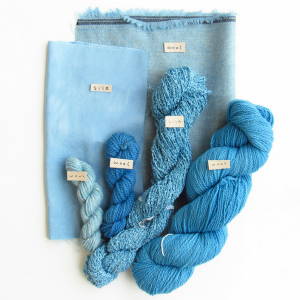Are Aquarelle dyes natural?
Yes, the dyes are from natural sources such as leaves, bark, fruit rinds, insects and roots. Several of the dyes are made from food processing waste products, such as pomegranate skins and Ayurvedic medicine. All the dyes and auxiliaries were evaluated for organic textile processing and have a certificate from Control Union that they comply with the Global Organic Textile Standard (GOTS).
Is the Liquid Indigo really Saxon Blue?
Yes. The liquid indigo is an improved version of Saxon Blue (also called indigo carmine), which was first created around 1740. The color is a distinctive turquoise or cyan color, quite different than traditional vatted indigo. Our version has been improved and has a better lightfastness rating. The advantage to using this indigo is that you do not need to create a separate indigo vat. Instead, the liquid indigo may be combined with the other Aquarelle colors right in the dye pot to create beautiful green, aqua, teal, purple, lavender and blue tones. It is to be used with protein fibers (wool, silk, alpaca) only.

Can I use these dyes with alum mordants?
Yes, the dyes work with alum mordants such as aluminum potassium sulfate and aluminum acetate. You may see different color results depending on the mordant that you use.
Do the dyes work on cellulose fibers?
Yes, the dyes work with cellulose fibers such as cotton, linen, hemp, bamboo, Tencel, except for the Liquid Indigo, which works best on protein fibers. On cellulose fibers, the liquid indigo is a very light sky blue and is not recommended.
